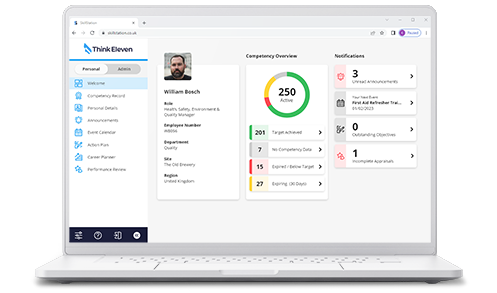Blended learning, incorporating eLearning, is the future of effective workplace training. This article explores the benefits of a blended learning approach, and provides steps for finding the right mix of training methods.
Effective workforce training and development is crucial to the success of any organisation. Whether it's enhancing an employee’s existing skills, or onboarding a new team member, effective training is essential to ensure that your workforce is equipped with the knowledge and skills needed to perform safely and competently. Whilst traditional classroom-based training and fully online training both have their own advantages and shortcomings, the future of effective workplace training lies in blended learning.
What is blended learning?
Blended learning combines a variety of different training methods, such as eLearning, training room-based instruction, and on-the-job training, to deliver a more effective and engaging learning experience.
This approach offers several benefits over a traditional single training method. For example, it leverages the strengths of different training types to create a comprehensive and personalised learning experience, it promotes higher employee engagement, boosts retention rates, and is a more flexible and cost-effective solution.
The benefits of eLearning
eLearning is usually a key component of a blended training approach. Its main advantages deliver self-paced, on-demand training, that employees can access anytime and anywhere. It’s a great way to reinforce learning after other forms of training have been completed, for example a Fire Awareness training course that forms part of a blended induction/onboarding process.
eLearning is a very cost-effective method that allows organisations to deliver engaging learning experiences with interactive and multimedia elements, such as videos, quizzes, and simulations commonly found in modern courses. These elements excel at promoting knowledge acquisition and understanding.
However, it’s important to note, when it comes to demonstrating proficiency, practical assessment strategies play a crucial role. Incorporating practical assessments alongside eLearning can provide learners with opportunities to apply their knowledge in real-world scenarios, reinforce their skills, and showcase their competency in a hands-on manner. By combining the strengths of eLearning's engaging content and practical assessments, organisations can ensure a comprehensive learning experience that enhances both knowledge and practical proficiency.
eLearning also offers excellent tracking and reporting capabilities. Managers can easily monitor learner progress and easily identify areas for additional support. This makes the process of evaluating training effectiveness as well as making any necessary improvements much easier.
The rise of a remote and flexible workforce has further enhanced the benefits of leveraging eLearning. For example, courses are accessible anywhere with an internet connection, can be paused and resumed to allow learners to work at their own pace and are a much more cost-effective way of delivering content without the need for bringing a dispersed workforce together physically for a training session.
Finding the right mix
While eLearning is a vital part of blended learning, it is important to note that in-person interaction and hands-on training are still crucial. Instructor-led training, mentoring, coaching, and on-the-job training should be integrated into a blended approach to provide a comprehensive learning experience.
Finding the right mix of a blended approach is key to a successful training program. Use the following steps below as a guide:
- Conduct a training needs analysis. Start by identifying the skills and knowledge that your employees need to perform their jobs effectively. Consider the specific job roles and tasks, as well as any areas where your employees may need additional training or support.
- Consider learning styles. People learn in different ways, so design your training program with this in mind. Practical and/or theoretical for example.
- Prioritise training methods. You’ll find some methods are more effective and resonate with learners more than others. Use this information to prioritise your methods and allocate resources accordingly.
- Stay flexible. Not all employees will respond to the same methods in the same way. Be ready to adjust your training program as required to ensure everyone receives the support they need.
It is vitally important that the effectiveness of the blended training program is evaluated regularly. This will help to inform any adjustments and refine your approach to achieve the best possible outcomes.
In conclusion
A blended approach has been proven to be an effective means to providing a competent and engaged workforce by many successful organisations globally.
A rise in remote and flexible workforces means this adaptation towards a blended solution, integrating various training methods such as eLearning is only going to accelerate forward with employees demanding the greater engagement and skills development this methodology brings.

